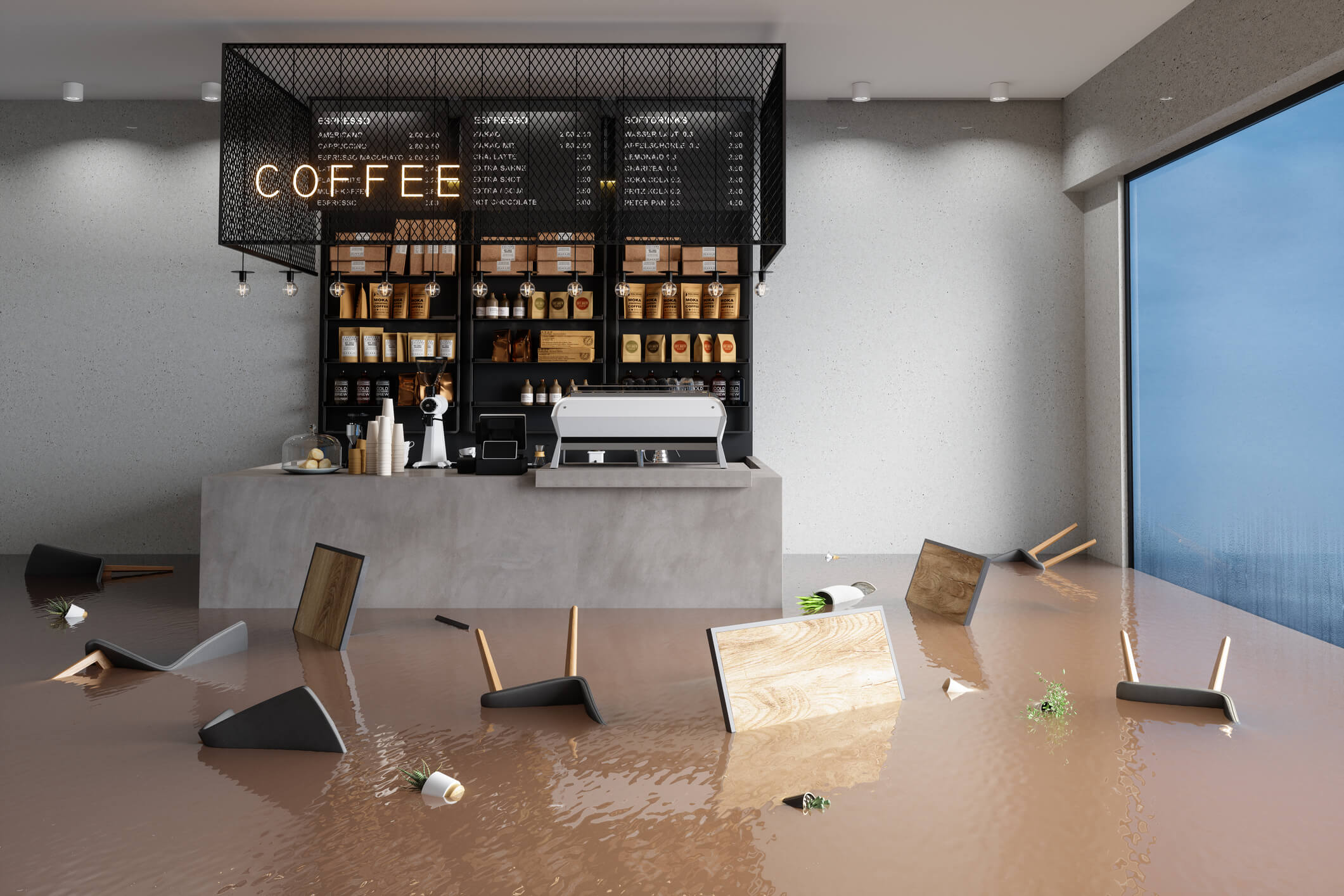How to prepare your business for storms, floods and bad weather
There are few things as unpredictable as the UK weather, which means we all need to prepare for all types of conditions, all year round. This is particularly important as a business owner - while a burst pipe at home could leave you in the cold for a day or two, a burst pipe at your workplace could mean you need to close and lose valuable business.
But is there anything you can do to reduce the risk of your business being affected by storms, high winds, ice and flood damage? Find out how to protect your business against storms, floods and bad weather.

What is bad or extreme weather?
Extreme weather refers to any bad or frequent weather event that causes major disruption to our lives. In the UK, we’re seeing an increase in extreme weather as the average global temperature continues to rise due to climate change.
Here are some examples of extreme weather conditions we experience in the UK:
Heat
Although UK summers aren’t known for extreme heat, that doesn’t mean we aren’t exposed to it. In fact, the frequency and intensity of heatwaves are increasing worldwide, and we’ve had a number of them in the UK over the past few years. Research from Global Health shows that without human influence, some recent heat events most likely wouldn’t have happened.
The amount of carbon we’re emitting into our atmosphere is heating the earth and resulting in extreme bursts of heat. While we might welcome the heat in the UK, in some countries, it causes drought, which can be devastating for local communities, including small businesses.
Concerned about climate change? Learn what businesses do to reduce carbon emissions and meet our net zero target.
Floods
When we hit the rainy season, the risk of floods increases. In recent decades, due to climate change, rain has gotten heavier. Now when it rains, it’s wetter, and it rains for longer, which can have devastating effects on people's homes and businesses.
Floods can kill small businesses. A report by Flood Flash shows that 40% of small businesses close for good after flooding, even those with flood insurance and good flood defences. The cost of damages is so high, that the floods take down not only flood barriers but the businesses behind them too.
Storms
A storm is an extreme weather condition made up of strong winds, downpours of rain and sometimes thunder and lightning. When a storm hits the UK, it’s all over the news!
Remember Storm Arwen in 2021 and Storm Eunice in 2022? Both brought major winds and rain and caused deaths, injuries and devastation to homes and businesses across the country. Specifically, storms can damage buildings and infrastructure — like power lines and grind public transport to a halt, causing absolute chaos and lasting damages.
Snow and ice
When winter hits, so does the snow and ice —- and in the UK, we’re not that well equipped to deal with it.
A small snowfall can cause dangerous driving conditions and take a while to get cleared. Not only do roads become hazardous, but as a result, many people are unable to get to work, and businesses have to close. The knock-on effect of bad snow can slow down the trading that so many small business owners rely on. Icy paths also lead to slips, falls and more chance of injury for employees and customers.
Are you covered if someone injures themselves on your business premises? Find out more about public liability insurance.
Strong winds
According to the Beaufort wind scale, a ‘strong gale’ can reach up to 88mph! That’s enough to cause branches to break, trees to fall and debris everywhere, causing hazards. During outbursts of strong winds, there is more risk of injury, travel disruption, power cuts and damage to buildings.
Extreme weather, like extreme wind, is not always predictable. Therefore it’s essential to have the relevant insurance in place to cover you — from building damage to injury. Learn more about business insurance and how Bionc can help get your business insured.
When is flood season?
Although flooding can happen whenever there is some rainfall, in the UK, it mostly happens during the autumn/winter months. October through to March can be prime flooding season for coastal towns and those situated along riverbanks.
But even if you don’t live near a river, surface water flooding can get into your property and cause damage, this is especially common in built-up areas where drainage systems can easily reach capacity and overflow.
Who is at risk of flooding?
You may think you’re only at risk of flooding if you’re business is situated on the seafront or next to a river — but this is not always the case. In fact, 1-6 properties are at risk of flooding in the UK.
You’re at risk of flooding if:
- You live in vulnerable areas of the UK, such as coastal areas such as Cornwall, Hull, Sussex and Kent.
- You live near the source of flooding, like a river or pathway. Heavy rainfall can flow down from hilly areas, where it goes into rivers and floods towns and cities. For example, the River Severn and River Avon in Worcestershire are very susceptible to flooding.
- If there is a drainage system on your property, it could get overwhelmed during heavy rainfall.
- You live in a low-lying area, if you’re elderly, housebound or without access to transport.
How to protect your business from storm damage
High winds and driving rain can cause all sorts of problems for your business premises, from flying roof tiles to burst gutters and problems with dampness.
Putting right the damage caused by business storm damage can cost a lot of time and money. The best way to protect your business from storm damage is to make sure everything on the building is as secure as it can be, so look out for the following:
The best way to protect your business from storm damage is to make sure everything on the building is as it should be, so look out for the following:
- Make sure all roof tiles are secure and any broken or loose ones are replaced.
- Make sure all gutters are properly attached and any blockages are cleared.
- Keep all external doors, windows and gates securely closed.
- Secure all fences and fence posts and remove or secure all outdoor furniture/displays.
If you own your business premises then it’s down to you to get the above sorted, but if you rent then could be the responsibility of your landlord.
Doing a bit of research in preparation for bad weather will help to make sure you know exactly what you are responsible for as a business owner, as well as what you personally need to put in place to safeguard the building, your staff, and yourself.
How to protect your business from snow and ice
The UK is always hit with a cold snap, so it’s important to know what you can do to prepare and protect your business when things freeze over.
Here are some steps to help make sure your premises are protected against snow and ice:
- Make sure all internal and external pipes are insulated, especially in unheated areas like the attic or basement. You can insulate them with foam or rubber tubes, remember to check them regularly to avoid erosion damage.
- Clear any outside paths of obstacles and put all outside seating and plant pots away.
- Take a note of where your internal stop tap is so you can turn off the water supply to the premises in an emergency.
- Make sure that any outside drains are unblocked as ice and snow will make the issue worse.
Even if you find yourself in the middle of a cold snap and haven’t taken any precautionary measures, it’s not too late to take steps to protect your business, so consider the following:
- Make sure you have your central heating on for at least an hour a day. This keeps hot water running through the pipes and creates a better working environment for staff as well as any customers coming in.
- Consider working from home if you and your employees can, or you could change working times to enable safe travelling into the premises in snowy conditions.
- Avoid any non-essential driving, you may have to postpone meetings, appointments or customer deliveries if it’s not safe to go out on the roads or if there are severe ice warnings in your area.
- Make sure you put salt on any outdoor steps or paths leading up to the premises to avoid any slipping accidents.
How to protect your business from flooding
Flooding can be a massive problem when a storm hits and you should always prepare for the worst, particularly if you live in a flood risk area. But how do you prepare your business for a flood?
It might sound obvious, but the best way to protect from flooding is to make sure you have a robust business flood plan in place, for both the short and long term.
Here are some things to consider as part of your business contingency plan for unpredictable weather:
Short-term flood planning
Check the Environment Agency website and see if there are flood warnings in your area. It’s also worth taking a look at the live flood warning map – you should immediately start planning for the worst if you spy a warning near you. Here’s how to prepare your business for an approaching flood:
- Make a list of important phone numbers, such as your business energy suppliers and your business insurance providers and keep them all in a watertight container along with any other important documents. Keep a torch and a fully charged phone in with the documents.
- Use sandbags to block any areas where water could enter your business premises, such as doors, windows and air bricks.
- If possible, move anything that's critical to the running of your business, such as stock, servers, computer equipment and the box of important numbers, to an upstairs room or as high off the ground as possible. If there’s anything you can’t move upstairs or that you still need for the day-to-day running of your business, such as furniture and fridges, try to raise them off the ground. It’s also worth moving them away from exterior walls to help with the drying-out process once the flooding begins to subside.
- If the floodwaters are imminent, unplug all electrical appliances, turn off your gas, electricity and water supplies, and never enter any standing water if the electricity is still on, or even if you’re unsure.
Long-term flood planning
If you’ve ever been the victim of flooding, then the odds are you’ll fall foul of floodwaters again at some point. So, it makes sense to put long-term plans in place to protect your business against future flooding. Here’s how to plan in the long term:
- Replace any downstairs carpets with sealed wood or ceramic tiles.
- Fit any water entry points, including doors and airbricks, with flood skirts and use water-resistant sealant on doors, windows, and skirting boards.
- Raise electrical sockets as high up the wall as possible.
- Plaster walls with waterproof lime plaster and get a chemical damp-proof course.
- Regularly check drains to make sure they’re clear from any blockages, which can exacerbate rising water levels, and fit one-way valves to pipes and water outlets so no water can flow back up them.
If you work from home and use a downstairs room as your office downstairs, it is worth moving to an upstairs room.
For a business flood plan template, check out GOV.UK.
There are also a few more things you can do for long-term flood planning. If you work from home and use a downstairs room as your office downstairs, it’s worth moving upstairs if you can.
Although preparing your workplace for the worst can help minimise the impact of flooding, it can’t completely protect against the potentially devastating consequences of flood damage to your business.
That’s why it’s vital to make sure you have quality flood insurance in place. If your business equipment and premises are damaged or destroyed by flooding, you need to be confident your insurance will cover the cost and your insurer can cope with your claim.
How to protect your business from strong winds
If high winds have been predicted in your area, then you should:
- Make sure staff vehicles or company cars or vans are parked away from any trees and are in a safe area.
- Make sure any company signs, outdoor seats, and basically anything that’s not fixed to the floor, are taken inside so they can’t be picked up by the winds and cause any damage.
- Inspect any worn building areas — check gutters aren’t clogged or loose and replace them to prevent further damage.
- For those with garages, consider installing single-wide garage doors that are more sturdy and less vulnerable to wind damage.
- Remember to note down all business equipment and valuables, including photos and detailed item descriptions. Secure a digital backup and provide your insurance advisor with copies. This is so you have evidence of your business assets in case they get damaged. Learn how to determine the value of your business assets with our guide.
How to make a business insurance claim for extreme weather damage
If you get hit by rain, wind, a storm, snow or another weather-related incident, you should follow these steps to making a claim:
- Make sure staff vehicles or company cars or vans are parked away from any trees and are in a safe area.
- Make sure any company signs, outdoor seats, and basically anything that’s not fixed to the floor are taken inside so they can’t be picked up by the winds and cause any damage.
- Inspect any worn building areas — check gutters aren’t clogged or loose and replace them to prevent further damage.
- For those with garages, consider installing single-wide garage doors that are more sturdy and less vulnerable to wind damage.
- Remember to note down all business equipment and valuables, including photos and detailed item descriptions. Secure a digital backup and provide your insurance advisor with copies. This is so you have evidence of your business assets in case they get damaged. Learn how to determine the value of your business assets with our guide.
How to make a business insurance claim for extreme weather damage
If you get hit by rain, wind, a storm, snow or another weather-related incident, you should follow these steps to making a claim:
- Keep everyone safe - If your business is damaged in some way, you may be tempted to go in and salvage what you can, but this can be dangerous. Floating debris and water-borne diseases could make you ill or injured. It’s best to call someone first to help. If you can, turn off gas and electricity if it’s safe to do, then get out of the property and get to safety on higher ground, taking customers and staff with you.
- Inform your broker or insurer - The next thing to do is contact your broker or insurer. Make sure you have their contact number and your policy number noted down somewhere digitally (or on your phone) so you can easily call. There is no need to panic at this stage - a broker or insurer will be well-equipped to take you through the claims process.
- Send pictures of damages - If possible, take pictures of the damages (as long as it’s safe to do so) — this includes damage to parts of your building, equipment, supplier and whatever else has been a victim of the weather-related event. Put this in a list and send it to your insurer or broker. Learn more about making a claim on your business insurance with our detailed guide
- Check your policies - You want to know what you’ll be covered for — and chances are — you probably don’t often check your insurance documents. Have a look at your package — does it include stock insurance, building insurance or business interruption insurance? It’s also worth checking the excess you’re expected to pay so you can make the funds readily available.
- Arrange an inspection if needed - When you eventually go back to your property, don’t clean it up straight away. When making a claim, your provider may want to come and inspect your business to check the damages to see what needs fixing or replacing.
- Fill out a claims form - Your insurance provider will send you a claims form to fill out. It’s key you do this as quickly as possible to avoid any delays. If you’re having trouble working out the costs of your claim - ask your insurer, broker or a loss assessor to help you. The insurance team at Bionic may also be able to help.
- Keep all receipts of repair work - When you return to your property and arrange any repair work. Keep all quotes, receipts and any comms with tradesman safe so you have evidence of your costs.
- Leave the rest to your insurer - Although it can be a stressful process, insurers deal with claims every day and are there to help your business get back up and running as soon as possible. Your insurer should keep you informed on a resolution or if there are any delays with your claim.
Does your business need an ‘emergency kit’?
Weather disaster kits, emergency kits or whatever you want to call them are essentially kits with everything you need for an emergency. In this case, it’s a good idea to have one in case of an extreme weather event! Here is a breakdown of what it should include:
Basic supplies
Whatever happens - come rain, wind or snow you’ll need basic supplies in case you have to leave your business premises. Make sure to include the following in your kit:
- Torch, with spare batteries
- Fully stocked first-aid kit
- Foil blankets
- Rubbish bags
- A power bank
- Water bottles and snacks
- Raincoats/macs
- Scarf, gloves and woolly socks
Haven’t got the time to think about making a kit? You can also purchase protection supplies for weather-related events online.
Business-specific items
- Employee accident book / first aid book
- Wrench or pliers to turn off any gas/electricity
- Reliable, updated contact information for key contacts, including local emergency departments, clients and vendors, and key decision-makers and stakeholders
Important documents
- Insurance information - policy number, policies, insurer or broker’s phone number.
- Bank details
- Identification
It’s best to store this digitally so it’s easily accessible in case any paperwork gets damaged during a flood or storm.
What type of insurance cover do you need?
If your business gets flooded, or damaged from wind or a storm, then it’s best to have cover in place to make sure you’re not left with thousands of pounds worth of repairs to pay for. Check your policies and check if you’re covered in case there is a flood, snow, or storm.
Bad weather events can also stop you from trading; in this case, it’s best to make sure your insurance package includes business interruption insurance.
If someone injures themselves on your property during a flood or due to falling/floating debris, then it’s essential to have public liability insurance — otherwise, you may get some unhappy customers making claims against you.
How to get the best business flood insurance
There will be thousands of business owners out there who haven’t checked their insurance policies for years. This means they’ll have very little idea about exactly what they’re covered for or even who they’re insured with.
Bad weather can strike any time, and there’s never a bad time to prepare your business for a weather-related problem and put things in place to look after your premises.
Even if you already keep on top of your policies, you could find that the cover you’ve always had in place is no longer enough for your business needs. This can be a real pitfall if you’ve recently moved into new premises that have been built in an area susceptible to flooding.
Protect your business from bad weather with Bionic
At Bionic, our insurance team can help you make sure you’ve got quality cover, with the right policies in place. Insuring your business against the unexpected will put your mind at ease in case there is a bought of nasty weather! Start a quote online with us today.
Interested in more insurance-related content? Head to our insurance guides from topics ranging from GDPR, and underinsurance, to preventing shoplifting and more.








